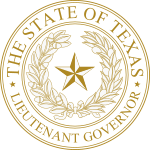Lieutenant Governor of Texas
| Lieutenant Governor and President of the Senate of Texas | |
|---|---|

|
|
| Style | The Honorable |
| Term length | Four years, no term limits |
| Inaugural holder |
Albert Clinton Horton 1846 |
| Formation | Texas Constitution |
| Website | Office of the Lieutenant Governor |
The Lieutenant Governor of Texas is the second-highest executive office in the government of Texas, a state in the U.S. It is the second most powerful post in Texas government because its occupant controls the work of the Texas Senate and controls the budgeting process as a leader of the Legislative Budget Board.
Under the provisions of the Texas Constitution, the Lieutenant Governor is President of the Texas Senate. By the rules of the Senate, the Lieutenant Governor establishes all special and standing committees, appoints all chairpersons and members, and assigns all Senate legislation to the committee of his choice. The Lieutenant Governor decides all questions of parliamentary procedure in the Senate. He or she also has broad discretion in following Senate procedural rules.
The Lieutenant Governor is an ex officio member of several statutory bodies. These include the Legislative Budget Board, the Legislative Council, the Legislative Audit Committee, the Legislative Board and Legislative Council, which have considerable sway over state programs, the budget and policy. The Lieutenant Governor is also a member of the Legislative Redistricting Board (together with the Speaker of the House, Attorney General, Comptroller, and Land Commissioner), which is charged with adopting a redistricting plan for the Texas House of Representatives, Texas Senate, or U.S. House of Representatives after the decennial census if the Legislature fails to do so.
In the case of a vacancy in the Lieutenant Governor's office, the Senate elects one of its members to act as President of the Senate until the next statewide office election, in effect becoming the Lieutenant Governor. A Senator elected as presiding officer in this way retains his district seat and the voting privileges entailed with his Senate election. The Lieutenant Governor is sworn-in on the third Tuesday every four years, the same as the Governor.
Dan Patrick has been the Lieutenant Governor of Texas since January 20, 2015.
The term of office was two years from 1846 to 1972. Voters then increased it to four years, effective for the 1974 election.
The Lieutenant Governor assumes the powers of the Governor of Texas when the governor is out of the state or otherwise unable to discharge the office. The Lieutenant Governor is elected separately from the Governor, rather than on the same ticket; it is therefore possible for the Governor and Lieutenant Governor to be from different political parties (which was the case during Governor George W. Bush's first term and also during Bill Clements's two non-consecutive terms). The Lieutenant Governor becomes Governor if the elected Governor resigns, dies or is removed from office via impeachment and conviction. Former Governor Rick Perry took office upon George W. Bush's resignation on December 21, 2000. Bush became US President on January 20, 2001. When Perry became lieutenant governor on 19 January 1999, he became the first Republican since Albert Jennings Fountain in 1873 to serve as lieutenant governor, and the Republican to be elected as Lieutenant Governor since James W. Flanagan in 1869.
...
Wikipedia

